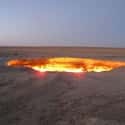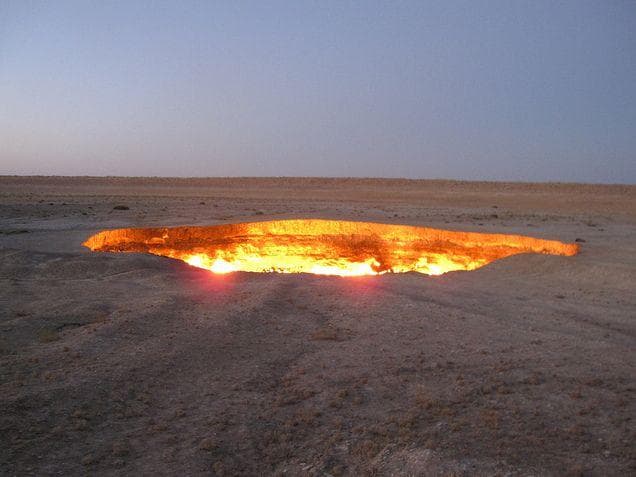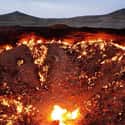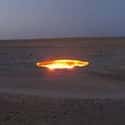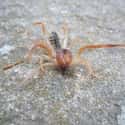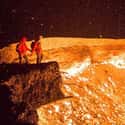-
(#5) The Accident Caused Several Craters To Open Up In The Desert
When engineers drilled into the Karakum Desert in 1971, they were expecting oil to gush out of the Earth, bringing riches to their homeland of Russia. Instead, what they got was a pit that devoured their equipment without warning.
By puncturing the Earth and letting the gas escape, the team unknowingly caused a chain reaction deep beneath the desert's surface. The pockets of methane gas were presumably linked to one another, and when one of the bubbles burst, the surrounding pockets emptied through the newly made hole.
In addition to adding fuel to the fire, the release of gas caused several more massive craters to form, similar to the one that swallowed up the team's campsite. Two craters are especially noteworthy: one’s filled with water, and the other contains boiling mud and embers.
-
(#3) When Engineers Started The Fires, They Didn't Realize The Blaze Would Never Stop Burning
After their camp was consumed by the Earth, the engineers realized that they had a serious problem on their hands. In addition to having possibly angered a sleeping demon, the methane gas they accidentally uncorked was rapidly seeping out into the atmosphere.
Nowadays, people are aware that methane gas is a greenhouse gas, and that its emission into the atmosphere perpetuates global warming. While scientists weren't very concerned about climate change in the '70s, they were aware that the gas could potenitally cause fiery explosions.
On average, the concentration of methane in the Earth's air stays locked at around 0.00017%. Once it reaches 5%, the likelihood of a methane-based fireball becomes uncomfortably high. As the pit continued to pump an incredible amount of methane into the atmosphere, the scientists were faced with a choice: leave it alone, or set it on fire.
Pragmatic as they were, the team set the site ablaze, believing that the pocket of gas would run out in a matter of weeks. While this is a fairly common practice for natural gas miners, this particular gas reserve seemed bottomless; nearly 50 years later, the fire is still burning.
-
(#8) The Pit Is Large Enough To Be Seen From Space
The Darvaza gas crater measures 226 feet wide, which is about the length of five semi trucks. On top of its girth, the crater is also 98 feet deep (roughly the height of a 10-story building). It’s so large that people standing on the far side of it look like specks of dirt, and it's clearly visible from space.
George Kourounis — the adventurer who led an expedition to the bottom of the crater —talked a bit about how the crater's size humbled him:
“There were a few moments that I just literally had to stop, look around, and drink in the spectacle of where I was. I could see my teammates up on the crater rim, just these tiny specks lit by this fire. You feel very, very small and very vulnerable in a place like that.”
-
(#7) It’s Said That Thousands Of Spiders Are Drawn To Their Deaths By The Pit's Flames
Tens of thousands of organisms have visited the Doorway to Hell, and not all of them are human. It has been reported that hundreds — if not thousands — of spiders have died climbing down into the crater. Allegedly, the creatures are attracted to the glow of the flames. Others posit that the animals are interested in nesting close to the crater's heat. While both these theories are backed by convincing evidence, it's also possible that the spiders are simply returning to the depths from whence they came.
-
(#6) A Team Staged An Expedition To The Bottom Of The Fiery Pit
Canadian explorer and adventurer George Kourounis took one look at the Doorway to Hell and decided that he wanted to see what was at the bottom. In 2013, he brought his crew — along with plenty of fireproof equipment — right to Satan’s front door. Kourounis's adventure had several motivating factors, the primary one being that he wanted to search for signs of underground life.
As it turns out, the space beneath the crater was home to several microscopic species. Upon investigating the theoretically inhospitable ground, the team discovered that the earth was rich enough to house bacterial. In an interview with National Geographic, Kourounis described his team's experience:
“Well, we were hoping to find signs of microbial life-forms that are thriving in the hot, methane-rich environment. Even if we found nothing, it still would have been a valid result and the expedition would have been worthwhile. But we were very fortunate. We did find some bacteria living at the bottom that are very comfortable living in those high temperatures, and the most important thing was that they were not found in any of the surrounding soil outside of the crater.”
New Random Displays Display All By Ranking
About This Tool
The Karakum Desert is one of the largest deserts in the world. There is a huge pit in the heartland that has spewed out raging flames for more than 40 years, making the night sky yellow. Local people call it the Hellmouth. In 1971, the former Soviet Union's drilling team and geologists accidentally discovered this cave while exploring natural gas resources there, and decided to ignite the gas in the cave and wait for the toxic gas to burn out before exploration, but the fire is still burning today.
It is a giant natural gas pit, the area where the giant pit is located contains a lot of oil and natural gas. In the dark night, the golden light from the flame can be seen from several kilometers away. You could find more details about the pit and there are available videos.
Our data comes from Ranker, If you want to participate in the ranking of items displayed on this page, please click here.

